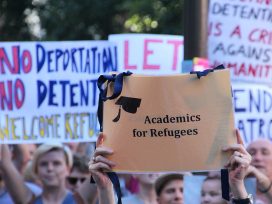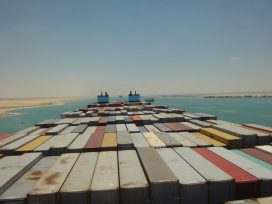When migration in post-“socialist” Eastern Europe is mentioned, the first thing that comes to one’s mind is forced and voluntary ethnic migrations within the region and labour migration from east to west. At this forum we are likely to speak more about the migration of the so-called highly skilled, from west to east, which is not only significant in its cultural impact but also much larger in its numbers than it is commonly thought to be. (Over a hundred thousand highly skilled Germans, for example, are employed in Poland.) What I would like to consider is another significant flow of people that entered the re-opened migration space of Eastern Europe: migrants from Asia.
I shall not attempt to review the heterogeneous mix of groups that could be classed as Asian migrants, from Indian engineers to Afghan refugees, from Arab students to Chinese traders. Instead, I shall turn to a single example: that of the Chinese, one of the largest, fastest-growing, most important, and most mobile groups in the region. The discussion will centre on Hungary, which has emerged as the main entrepôt of Chinese migration and entrepreneurship in the region; but what is said about Chinese in Hungary can arguably be applied to Chinese in Central Eastern Europe in general. Although I will exclude from my discussion the very particular and complex migration picture of the former Soviet Union, the Chinese are a very important group of migrants in the post-Soviet states as well, a point that I shall return to in some more detail.
Before 1989, Asian presence in the region was limited to Vietnamese guest workers in Czechoslovakia and East Germany and to Arab students (Vietnamese and Chinese students were very few), the largest number of whom was in Romania. After Eastern Europe opened up to new migration, these communities expanded and changed profile, with trading becoming their main occupation. Romania today hosts more than ten thousand Arabs: Lebanese nationals alone have registered some two thousand companies in Romania since 1990, while Syria is in the third place in terms of the number of companies with foreign capital (Open Media Research Institute 1996). In the Czech Republic, more than 9 thousand Vietnamese citizens held permanent or long-term residence permits in 1994 (Directorate of Alien and Border Police 1994).
The Arabs and Vietnamese, although they have, in small numbers, spread across the region, have shown less mobility than the Chinese. These newcomers, in a decade, have radiated from their early target countries – Russia in the east and Hungary in the middle – to occupy visible positions in trade and catering in nearly all countries of the region (with the exception of the Balkans and the Baltics). Their numbers range from several thousand to several tens of thousands (and probably several hundred thousand in Russia), and, against the odds of unpredictable immigration policies and hostile borders, they move between these states to pursue business opportunities almost as if they were already part of a united Europe. In this respect, the Chinese are, indeed, “the best and the oldest Europeans” (Pieke 1998) in a region that still clings to its borders strongly enough to kill for them.
Sociodemographical profile
Since the launch of economic reforms in the People’s Republic of China (PRC), internal and international migration, which had been suppressed before 1978, has been growing strongly. Cities and coastal regions became sending areas of the international migration of a new consumer society. Chinese students and exchange scholars, who had been going abroad in significant numbers since 1978, were forerunners of sorts of this migration. After the 1989 crackdown in Tiananmen Square, a particularly large number of students and scholars settled abroad. At the same time, Tiananmen gave a kick to entrepreneurial migrants: the young private economy was feeling uncertain about its chances to be permitted to survive in the future. The two flows met and began to mingle, which was facilitated by the students’ moving away from political dissidence and increasing interest in doing business with China.
Large-scale Chinese migration to Hungary was triggered by Tiananmen. Chinese at that time discovered the visa-free travel agreement that had come into effect in 1988, and found that the country was both a gateway to Western Europe and a promising enough place to bring their capitals to. From 1989 to 1991, the Chinese population in Hungary grew from practically zero to around 40,000. Hungarian officials reacted by re-imposing the visa requirement in early 1992, periodically freezing the granting and extension of stay permits to Chinese, and rounding up undocumented Chinese migrants. This resulted in a secondary migration to Poland, Czecho-Slovakia, Romania, and to a lesser extent other countries of the region, as well as Western Europe, with only around 10,000 remaining in Hungary. In the meantime, following the collapse of the Soviet Union and the relaxation of the Russia’s border regime, Chinese traders as well as contract workers and farmers have targeted both Russia’s Far East and Moscow, resulting in a likely presence of several hundred thousand and provoking a loud reaction by politicians and the media. From Russia, the Chinese have also begun migrating further to the Ukraine, Belorussia, and the Central European states.
Early Chinese migrants to Hungary, in their motivation and background, showed a picture that was different from migrants from traditional qiaoxiang (migrant homelands) that had dominated the Western European scene until the seventies. These migrants typically came from the urban-coastal zones of the PRC, are upwardly mobile, educated above average, and individually motivated. This was different from qiaoxiang migrants, who come from a rural environment with a hereditary tradition of and an economic dependence on emigration. By the middle of the decade, however, Zhejiang and Fujian, two provinces with strong emigration traditions, developed qiaoxiang that were catering specifically to Eastern Europe. Jiangyin and Jiangjin townships in Fuqing County, Fujian, are now specialising in migration to Hungary, Germany, and Russia; Mingqi township near Sanming city, Fujian, in migration to Hungary and Italy; and Wenxi village near Wenzhou city, Zhejiang, in migration to Hungary. This is due to three factors: first, to the emergence of a few successful migrants from these localities in Hungary that attracted a chain of relatives and friends; second, to the development of a system of semi-legal migration brokerage, ranging from “snakeheads” producing forged documents to government agencies procuring official invitations from Hungary; third, to the tacit encouragement of emigration by poorer localitiesin these provinces that see in it a chance to improve their prosperity vis-à-vis the old qiaoxiang. In 1996, the Sanming city government actually asked the Hungarian embassy to delegate to it the authority to issue visas.
In Western Europe, qiaoxiang migrants form self-contained ethnic niches in Western European economies based on restaurants or workshops. The main occupation of Chinese in Hungary is trade, including imports, wholesale, and retail. In Hungary and other Eastern European countries, the Chinese took advantage of economies that were, to varying degrees, undersupplied, and filled a supply gap by offering cheap but popular clothes of the kind made in China for low-price Western retail chains. Contrary to traditional Chinese migrants to Western Europe, these migrants had the cultural capital, the mobility, and the means of communication to develop close ties with state enterprises in China, which supplied them with merchandise at low subsidised prices and on favourable consignment terms. In the early nineties, Hungary became the distribution centre of Chinese imports to Eastern Europe, with traders from Poland, the Ukraine, and Yugoslavia flocking to the large market in Budapest where most Chinese wholesalers were based.
In Western Europe, when the ethnic economic niche was filled, Chinese traditionally chose to move to new terrain and continue in the same business; hence the gradual spread of Chinese restaurants across Western Europe from the sixties through the eighties. By contrast, Chinese businessmen and -women in Hungary, when the clothes and shoes market suffered a depression starting in 1995, started to diversify their businesses, in some cases expanding into exports, services, or production. At the same time, they accelerated spreading their business into other countries of the region and obtaining residence titles there; but they kept their businesses and often their residences in Hungary, more like an investor balancing his portfolio. Thus, the Chinese ethnic economy in Hungary is much more open and able to take advantage of opportunities in the host economy than it has been the case in Western Europe, and secures rapid upward mobility for its members.
One of my informants, in China a state bank employee with a driver and bonuses sometimes as high as $5000 a month, is a good if not quite typical example. Unlike in the case of qiaoxiang migrants, it was no longer a general “European dream” that brought this man and his likes to Hungary, but a comparison, informed or otherwise, of specific opportunities. While he believes that more money can be made in China, he also thinks that competition is tougher and failure more dramatic. The international Chinese trade network, which criss-crosses particularly the Pacific rim, is there for anyone to benefit from in China, but it becomes a competitive advantage overseas. Therefore, to the new migrants, existing Chinese populations are not just a pull factor – as they are in traditional chain migration – but simultaneously a push factor, since more Chinese make more competition. New Chinese migration is opportunistic, pushed by the psychological and social rather than the existential consequences of overpopulation and pulled by (perceived) opportunities to make money and, by gaining foreign residency or citizenship, move freely around the world. Peasants in the traditional migrant homelands of Southeastern China respond very quickly to changes in the economies or immigration policies of remote European and American nations and readily – if erroneously – discuss the amnesty for illegal immigrants in Italy or the garments market in Eastern Europe.
Beneficiaries and movers of globalisation
Indeed, Chinese in Eastern Europe display both an extraordinary geographic mobility and a high degree of willingness to change social roles. I have interviewed people who started trading in Hungary, were unsuccessful or lost their money at the casino, and went to Italy or Germany to work in leather workshops or restaurants for three or five years; now they consider investing the money earned in Hungary or Romania once again as they want to develop their own business. Others, whose application for political asylum in Germany was turned down, chose to re-enter Hungary illegally, because they thought it was easier to re-legalise their status there. Several more who started trading in Russia in the early nineties went on to Hungary, but as residence permit policies were tightened in 1992, went back to Russia. In other words, migration, even illegal migration, is happening not just from East to West, but also in the opposite direction.
It would seem that Chinese entrepreneurs, being as mobile and opportunistic as they are and thriving on the freedom of the labour and goods market, are par excellence beneficiaries of the Western globalisation discourse. To some extent, they are aware of that discourse and use it. When they arrive in Eastern Europe, they expect to see McDonalds, Hallmark greeting cards and immigration-for-investment arrangements, and not seeing the latter two, refer to the experience of Western (Anglo-Saxon) countries as the way it should be. Yet Chinese transnationals fill the globalisation discourse with authentic content.
I am not talking here about the global polularity of “Oriental culture” embodied in books on fengshui and oriental mysticism, which are marketed through Western structures and often written by Westerners (on the Hungarian market, most of the Chinese cookbooks and fengshui books are by English authors, simply because they are easier to translate). This would just be another item picked up by Western actors on the global marketing scene, just as McDonalds picks up items with a local flavour in one country and transfers the standard technology to other countries. I am talking about the discourse of belonging that puts migrants within the scape of a “global majority” and its organisational and symbolic underpinnings, its use in business networking, and the recruitment of non-Chinese into the business structures that work within that discourse.
The idea that first-generation Chinese migrants tend to consider themselves as sojourners only temporarily on foreign territory is a cliché in overseas Chinese studies. Its validity for new migrants was eloquently demonstrated when, before a conference co-organised by Chinese organisations, a Hungarian NGO, and the Budapest city government in 1995, some of the Chinese organisers raised the idea that the Chinese should work toward being recognised as an ethnic minority in Hungary. The reaction in the Chinese community, even by those who supported the activists that made the proposal, was largely negative: “Chinese cannot be a minority anywhere!” Apart from the association of the word “minority” with “backward” ethnies such as Tibetans and Uyghurs in China, I suggest that the rejection of a minority identity reveals a self-view of belonging to a mobile “global majority” that is more important that the more or less incidental fact of being a momentary minority in a country inhabited by a strange people.
Li Yiyuan (1970) has argued that overseas Chinese dialect groups (which form the traditional Chinese transnational communities of Southeast Asia, North America, and partly Western Europe) apply three models to the construction of their identity and relations with the outside. The first is the “immediate model”, which informs the set of cultural characteristics that identify the group itself. The second is the “internal observer model”, which positions the community vis-à-vis other dialect groups. The third is the “ideological model”, which constructs the group’s belonging to a pan-Chinese cultural community. When external influence from the host society is limited, the ideological model plays little role; but when external influence is intense, the ideological model is used either in uniting various dialect groups or in attempts by one of them to establish hegemony over the others.
The discourse of belonging of the Hungarian Chinese community clearly rests on the ideological model. In qiaoxiang migration, the immediate and internal observer models have been at least as significant as the ideological model, since direct contacts with the qiaoxiang accounted for the greater part of relations with China and created a distinction between migrants hailing from different regions. The discourse of belonging of the new Chinese transnational community is based on a pan-Chinese identity, rather than on ethnic (Cantonese, Wenzhounese, etc.) identities typical of traditional overseas Chinese communities. In both trade and the political sphere, the China they left but continue to deal with is a centralised China, represented by national organisations and commercial enterprises from all around the country. The symbolic core of the new Chinese transnational community is not the qiaoxiang but Peking. The political institutions and status quo of the PRC form a vital part of the shared discourse of belonging. This is especially so since most larger Chinese businesses in Eastern Europe rely on connections to PRC state enterprises and government agencies for a fast and cheap access to goods, cash, and market information. This network has largely replaced the traditional kinship- and native-place-based networks of qiaoxiang migrants. The qiaoxiang is no longer the preferred or only source of goods and locus of investment. As within the PRC, connections with the qiaoxiang political-economic elite constitute political capital that can be converted into financial capital, but it only becomes significant at the level of the big city or province. Its value is not greater than that of similar relations with other city and provincial elites, and certainly less than that of such relations with the national elite in Peking.
Chinese organisations in Hungary, the Hungarian Chinese Association (HCA) in particular, have used the ideological model in appealing to the entire community as their base and in their struggle for legitimization and power. HCA’s former president, who know chairs the European Federation of Chinese Organisations (EFCO), has relatively high official titles in government organisations in four Chinese provinces, none of which is his native province, and is a regular guest at top state functions who has been received by PRC Chairman Jiang Zemin himself. EFCO itself, created in 1992, consists largely of new organisations founded with the approval of the PRC embassies and province-level authorities, which share remarkably standardised rituals and symbols. When one walks into the office of the Fujian tongxianghui (native-place organisation) in Paris, one sees the same photographs with Chinese leaders and the same little banners from fellow organisations in Europe and from overseas Chinese affairs authorities in China that hang at the office of the Fujian tongxianghui in Bucharest. When organisations convene for a celebration of the Spring Festival or of the PRC’s official holiday, the same congratulatory telegrams are read out from fellow organisations and Chinese government agencies, in the same order, and the same speeches are made. This new organisational structure of the Chinese transnational community is a vehicle of the deterritorialised, symbolically Peking-centred nationalism which has lately been used by the PRC government to legitimize itself both domestically and vis-à-vis the overseas Chinese.
But does this alternative globalisation have any impact outside of the Chinese communities? The interaction between Chinese and locals usually takes place at the market, at the fast-food joint, at the karaoke parlour, or perhaps in the apartment block. It can be called an exchange of “gesunkene Kulturgüter”: Chinese learn a crude form of market Hungarian, form an impression of Hungarian food based on what is available at open-air markets, and pick up prejudice against Gypsies. Hungarians learn a crude form of Chinese – Hungarian waiters in Chinese restaurants are often able to communicate with it – believe that spitting is not a sign of bad manners in China, and learn prejudice against Fujianese. As tolerance on the fringes of society is greater, Chinese are often on good terms with Gypsy employees and, especially in rural areas, there are Chinese-Gypsy cohabitations and even marriages. Yet these forms of cultural interaction are distinctly local. The impact of Chinese globalisation, on the other hand, is traceable in larger Chinese businesses in Hungary that employ Hungarians in various positions from sales clerks to managers, likely several thousand in total.
Even taking into account tax and duty evasion, treasury revenues from Chinese businesses, which handle some three-quarters of Chinese-Hungarian trade, are considerable, as is the spending of Chinese, as witnessed by casino managers, some of whom who have privately estimated that Chinese account for over half of their clientele. Apart from permanent employees, the Chinese community is surrounded by an aura of “compradores”: Hungarians ranging from labourers to students, lawyers, and accountants who depend on the Chinese community and in some cases borrow their business practices. Chinese migrants in Hungary have been able to form a highly successful ethnic economy which, precisely because of its openness to the economic environment, did not need to adapt its ways of trading to the latter; instead, it has prompted some of the actors in the host economy to adapt. The rapid generation of high incomes relative to the environment have meant that, instead of learning the local language, the Chinese could afford to hire local interpreters and assistants. For a Hungarian or Russian student majoring in Chinese, employment at a Chinese trading company or a travel agency catering to Chinese is often a relatively lucrative alternative to scarce and underpaid academic and foreign-service positions. Such employment offers a career that, if appropriate modes of interpersonal interaction and business methods are followed, may provide significant geographic and social mobility. For example, I have interviewed a Russian graduate of the university in Vladivostok who was invited by a Chinese employer to move to Moscow and several Hungarian employees of Chinese companies in Budapest who are regularly sent to China on business. Obviously, the models of behaviour that lead to success in this world are quite different from those that an East European graduate must learn when he or she enters, say, Procter & Gamble; but they, too, have global validity. The assimilation of Hungarian individuals and businesses into the Chinese business network, the reverse of the formation of the original “compradore bourgeoisie” in the concession ports of China after the Opium Wars, is an interesting example of the expansion of the Chinese world system. It proves that globalisation is not a single process of which the West is the agent, but a multiplicity of parallel globalisations, of which non-Western transnational communities can be both aspects and agents (see Hamashita 1997 and Ong and Nonini 1997).
References
Directorate of Alien and Border Police, Information on Migration on Czech Republic Territory. Prague: 1994.
Hamashita Takeshi , “The Chinese World-System,” in Peter Katzenstein and Takashi Shiraishi, eds., Network Power: Japan and Asia. Ithaca: Cornell University Press, 1997.
Li Yiyuan, Yi ge yizhi di shizhen: Malaiya huaren shizhen shenghuo di diaocha yanjiu [A transplanted township: a study of urban Chinese life in Malaya]. Taipei: Institute of Ethnology, Academia Sinica, 1970.
Aihwa Ong and Donald Nonini (eds.), Ungrounded Empires: The Cultural Politics of Modern Chinese Transnationalism. New York and London: Routledge, 1997.
Open Media Research Institute Daily Digest , 60 (25 March 1996), Part II.
Frank N. Pieke, “Introduction,” in Frank N. Pieke and Gregor Benton, eds., The Chinese in Europe.
Basingstoke, Hamps., and New York: Macmillan and St. Martin¹s Press, 1998.






